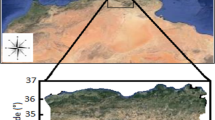Abstract
For irrigation in agriculture, water is a natural resource. Recycling water use is vital for the sustainable development of ecological environment and for resource conservation. Different substances that are thought to be pollutants and contribute to the deterioration of water quality are present in the wastewater from daily life and industrial activity. This research propose novel method in agricultural water management using feature extraction as well as classification based on DL methods. Inputs are collected as agriculture field water management as well as processed for noise removal, normalization and smoothening. Processed input data features are extracted utilizing kernel convolutional component analysis network. The extracted features has been classified using Quadratic reinforcement NN. Experimental analysis are carried out in terms of accuracy, precision, recall, positive predictive value, RMSE and mAP. Proposed technique attained accuracy of 92%, precision of 86%, recall of 65%, positive predictive value of 71%, RMSE of 55%, MAP of 51%.





Similar content being viewed by others
Availability of data and material
All date available in Manuscript.
Code availability
All date available in Manuscript–Custom Mode.
References
Abioye EA, Hensel O, Esau TJ, Elijah O, Abidin MSZ, Ayobami AS, Yerima O, Nasirahmadi A (2022) Precision irrigation management using machine learning and digital farming solutions. AgriEngineering 4(1):70–103
Abowarda AS, Bai L, Zhang C, Long D, Li X, Huang Q, Sun Z (2021) Generating surface soil moisture at 30 m spatial resolution using both data fusion and machine learning toward better water resources management at the field scale. Remote Sens Environ 255:112301
Ahansal Y, Bouziani M, Yaagoubi R, Sebari I, Sebari K, Kenny L (2022) Towards smart irrigation: A literature review on the use of geospatial technologies and machine learning in the management of water resources in arboriculture. Agronomy 12(2):297
Alshehri M, Kumar M, Bhardwaj A, Mishra S, Gyani J (2021) Deep learning based approach to classify saline particles in sea water. Water 13(9):1251
Altalak M, Ammaduddin M, Alajmi A, Rizg A (2022) Smart agriculture applications using deep learning technologies: a survey. Appl Sci 12(12):5919
Assunção ET, Gaspar PD, Mesquita RJ, Simões MP, Ramos A, Proença H, Inacio PR (2022) Peaches detection using a deep learning technique—A contribution to yield estimation, resources management, and circular economy. Climate 10(2):11
Cordeiro M, Markert C, Araújo SS, Campos NG, Gondim RS, da Silva TLC, da Rocha AR (2022) Towards smart farming: fog-enabled intelligent irrigation system using deep neural networks. Futur Gener Comput Syst 129:115–124
Dehghanisanij H, Emami H, Emami S, Rezaverdinejad V (2022) A hybrid machine learning approach for estimating the water-use efficiency and yield in agriculture. Sci Rep 12(1):1–16
El Bilali A, Taleb A, Brouziyne Y (2021) Groundwater quality forecasting using machine learning algorithms for irrigation purposes. Agric Water Manag 245:106625
Jung C, Ahn S, Sheng Z, Ayana EK, Srinivasan R, Yeganantham D (2021) Evaluate river water salinity in a semi-arid agricultural watershed by coupling ensemble machine learning technique with SWAT model. JAWRA J Am Water Resour Assoc 58:1175
Kayhomayoon Z, Azar NA, Milan SG, Moghaddam HK, Berndtsson R (2021) Novel approach for predicting groundwater storage loss using machine learning. J Environ Manage 296:113237
Lowe M, Qin R, Mao X (2022) A review on machine learning, artificial intelligence, and smart technology in water treatment and monitoring. Water 14(9):1384
Nosratabadi S, Ardabili S, Lakner Z, Mako C, Mosavi A (2021) Prediction of food production using machine learning algorithms of multilayer perceptron and ANFIS. Agriculture 11(5):408
Pallathadka H, Mustafa M, Sanchez DT, Sajja GS, Gour S, Naved M (2021) Impact of machine learning on management, healthcare and agriculture. Mater Today: Proceed
Perea RG, Ballesteros R, Ortega JF, Moreno MÁ (2021) Water and energy demand forecasting in large-scale water distribution networks for irrigation using open data and machine learning algorithms. Comput Electron Agric 188:106327
Shuang Q, Zhao RT (2021) Water demand prediction using machine learning methods: a case study of the Beijing–Tianjin–Hebei region in China. Water 13(3):310
Sung JH, Kim J, Chung ES, Ryu Y (2021) Deep-learning based projection of change in irrigation water-use under RCP 8.5. Hydrol Process 35(8):e14315
Tan R, Ottewill JR, Thornhill NF (2020) Monitoring statistics and tuning of kernel principal component analysis with radial basis function kernels. IEEE Access 8:198328–198342
Wanniarachchi S, Sarukkalige R (2022) A review on evapotranspiration estimation in agricultural water management: past, present, and future. Hydrology 9(7):123
Zhou Z, Majeed Y, Naranjo GD, Gambacorta EM (2021) Assessment for crop water stress with infrared thermal imagery in precision agriculture: A review and future prospects for deep learning applications. Comput Electron Agric 182:106019
Acknowledgements
The researchers would like to acknowledge Deanship of Scientific Research, Taif University for funding this work.
Author information
Authors and Affiliations
Corresponding author
Ethics declarations
Conflict of interest
The authors declare that they have no conflict of interest.
Ethical approval
This article does not contain any studies with animals performed by any of the authors.
Informed consent
Informed consent was obtained from all individual participants included in the study.
Additional information
Edited by Prof. Antonio Zuorro (GUEST EDITOR) / Dr. Michael Nones (CO-EDITOR-IN-CHIEF).
Rights and permissions
Springer Nature or its licensor (e.g. a society or other partner) holds exclusive rights to this article under a publishing agreement with the author(s) or other rightsholder(s); author self-archiving of the accepted manuscript version of this article is solely governed by the terms of such publishing agreement and applicable law.
About this article
Cite this article
Lin, YC., Alorfi, A.S., Hasanin, T. et al. Water agricultural management based on hydrology using machine learning techniques for feature extraction and classification. Acta Geophys. 72, 1945–1955 (2024). https://doi.org/10.1007/s11600-023-01082-9
Received:
Accepted:
Published:
Issue Date:
DOI: https://doi.org/10.1007/s11600-023-01082-9




